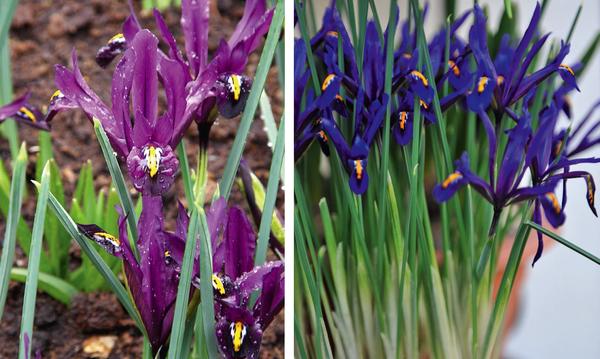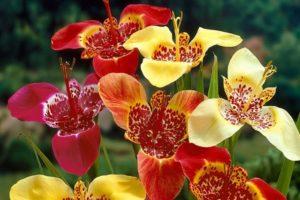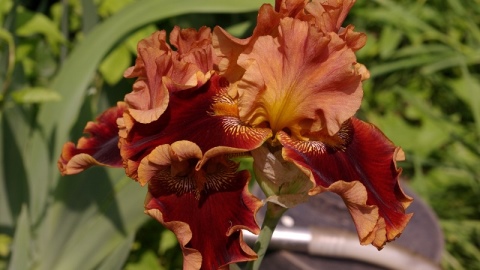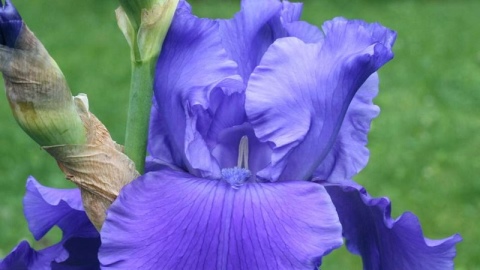Features of planting irises
Planting bulbous irises includes several mandatory procedures. This is the preparation of bulbs, drainage and fertilization of the soil, mulching. Knowing all the secrets of growing Dutch bulbous iris, especially planting and care, you can achieve an excellent decorative effect.
Preparing the bulbs for planting

Bulbous plants are susceptible to fungal diseases, so Dutch iris bulbs require special preparation before planting. Planting material must be purchased at proven flower and gardening shops. When buying, you should inspect the bulbs, there should be no damage.
If the bulbs were stored at home, they should also be carefully examined. Bulbs that have rot, painful spots, it is better to immediately set aside and discard. Good specimens should be treated with antifungal drugs. For these purposes, fungicides "Maxim", "Fundazol" are used. Many gardeners use a strong solution of potassium permanganate. Iris bulbs are placed in this solution for 30-40 minutes. After drying, the bulbs are ready for planting.
How to choose a place and prepare the ground
Irises do not pose much of a hassle to grow, but some plant preferences must be reckoned with. Irises do not like shade, poor soil, waterlogged soil. When choosing a place for planting these flowers, you need to give preference to a sunny place, and in order to prevent moisture stagnation, you can place them on an artificially created slope.
To do this, make a small elevation with a slope, equip a good drainage system. When irises are planted in 20 cm high beds, it is possible to ensure the natural drainage of rainwater. No matter how close the groundwater is to the surface, it cannot endanger the roots.
The soil must be filled with nutrients before planting. For this, organic fertilizers are applied. Then the earth is carefully dug up and loosened. If you start preparing the soil in advance, about a year in advance, you can add manure. Calcareous soils are best suited for bulbous crops. If the soil does not match, you can add eggshells, chalk or lime to it. Humus is added to the sandy soil. It is useful to add superphosphate or ash at a rate of 40 g / 1 sq. meter. Clay soils are enriched with coarse sand, a small amount of compost or humus.
Hybrid iris varieties can grow in one place for five to ten years, depending on the variety. Irises grow very quickly, this quickly depletes the soil, you have to choose new places for planting these flowers.
A hole is dug under each bulb, for the northern regions it is necessary to make a depth of about 14 cm, for the southern regions - about 10 cm. A gap of 15 centimeters is left between the holes, in such conditions the plants will develop adequately.
Names and descriptions of the best varieties of bearded irises
"Kopatonic"
The flowering period is from May to June and lasts about 2-3 weeks. It reaches a height of 85 cm, it is a tall variety. Large flowers from 10-15 cm in diameter are painted in ruby-red shades with a bright reddish border and mustard-yellow beard, colors often vary from orange to brownish. Forms corrugated lace flowers, 7–8 on one peduncle.
This hybrid variety has high winter hardiness. The distance between mature bushes should be 40-60 cm. Strongly overgrown irises of this variety stop blooming.
Devil's lake
This tall iris reaches a height of 100 cm.It begins to bloom in July, has a dark blue monochromatic color of the petals. The stem can have up to 4 branches and 6–8 flowers are formed. The diameter of a very large flower is about 11–18 cm. The petals are covered with light corrugated ripples. The color of the beard is blue, at the core it is yellow.
"Wabash"
This is a kind of bearded iris 70–90 cm high. The fragrant flowers are painted in two shades: the upper ones are pale white, the lower ones are bright purple with a white border. The beard is yellowish. 8-9 flowers are formed on one bush in June. It is a cold-hardy, winter-hardy variety that does not succumb to pests and diseases. Old plants do not even need to be covered for the winter in the middle lane, with the exception of a snowless winter.
It tolerates light shading well, but must be protected from strong winds. The soil before planting requires preparation of the drainage system, irises "Wabash" do not withstand an excess of moisture. The soil for planting is neutral or slightly acidic.
"Decadence"
It begins to bloom in June. The height of adult plants reaches 95 cm. Flowers are large, two-colored, fan-shaped with three drooping petals. Light yellow crown and burgundy-cherry lower petals with golden corrugated border. Short tangerine beard. Photophilous, but prefers light partial shade at noon. It is recommended to plant in an area where the sun is about 5 hours a day. It tolerates acidic, clayey, loamy and sandy soils well.
World premier
Flowering begins in June and continues in July. Tall bushes with peduncles up to 90 cm give large flowers 13-15 cm, up to 6 pieces on each plant. The upper petals are lilac-blue, and the lower ones are deep blue with a blue edging. Dark gold beard. Blooms for several weeks, individual specimens - from 1 to 5 days. Prefers neutral soils: loose, sandy-clayey, slightly humus. The distance between plants is 30 cm.
"Supreme Sultan"
The unpretentious variety has a long flowering period from June to July. Loves sunny places, sheltered from the wind. Reaches a height of 100 cm. Huge flowers up to 19 cm are painted in two colors: an orange-saffron upper part is combined with falling petals in mahogany shades. The beard resembles the tongues of an extinguished flame. The bush gives 3-4 peduncles, 8-9 buds develop on each. Has a characteristic sweet aroma.
Ever after
Hybrid variety. Blooms in June-July. On the bush grows a peduncle tall 85–90 cm with 5–6 flowers. The upper part is fuchsia, the lower one is bright pink, fading towards the center. Orange goatee and ribbed edges. The aroma is bright and fragrant. Loves sunny areas, but tolerates partial shading well. The soil is slightly acidic, neutral and slightly alkaline.
Caribbean dream
It begins to bloom in May. It reaches a height of 90 cm. Monochromatic blue flowers with a lilac tint, corrugated petals, with light lace, between which there is a white thick beard. Has a characteristic vanilla aroma. Winter hardy variety. Prefers lighted and wind-protected areas, fertile soil with drainage.
Succes fou
Blooms in July. The height of the peduncle is up to 90 cm. Large flowers of a pale pink shade are not afraid of rain and bright sun. A pale coral beard. Transfers a slight shadow. Does not differ in frost resistance. Prefers slightly acidic, neutral and slightly alkaline soils.
Sultan Palace
It opens flowers in May and continues to bloom for two weeks. Stem height - 55-60 cm. Solid bright red petals form a dome, darker fouls with a slight ripple along the edge. Golden curly beard and delicate sweetish aroma. Flower size up to 15 cm. Winter-hardy variety.
How to plant?
Planting germanica is carried out in open ground in early spring, but crops of this kind can also be successfully rooted throughout the summer, until autumn.Planting is usually done after the plant has finished flowering or before it begins. Iris german also requires certain preparatory measures before rooting in the garden. First of all, you should choose the best suitable place for growing flowering crops. The site must meet the following requirements:
for most varieties, it is important that the flower bed is sufficiently lit;
all varieties must be reliably protected from gusts of wind so that their stem, notable for its impressive height, does not break;
there should be no stagnation of water in the soil, including it is desirable that groundwater does not lie close to the surface of the earth;
it is best that the soil has good aeration - you need to take care of high-quality drainage in advance;
the soil in the front garden with iris should be as nutritious as possible, with a high level of minerals.
Regardless of the chosen planting time, the area for the iris should be prepared in advance - it is better to do this in the spring. It is for this reason that compost and other fertilizing useful for a flowering culture should be introduced into the ground.
The disembarkation algorithm looks like the one described below.
- Immediately before the rooting of the flower in the ground, the selected planting material must be treated with any growth stimulant. For plants that will be planted in open ground in spring, such an event is mandatory.
- The next step is to shorten the length of the root system, as well as remove wilted, dry, or rotten areas. Pruning should be done with pre-decontaminated scissors or a sharp knife.
- Then you need to prepare the soil in the garden for planting. For these purposes, in the ground, you need to make a hole 20-25 cm deep.
- The rooting process itself involves placing the iris in the middle of the pit, after which the rhizome is sprinkled with soil, a small amount of river sand must be poured on top.
- When rooting several plants, a distance should be left between them, which should not be less than 50 cm.
- The final stage of iris planting will be watering. The first moistening in the new place should be abundant, however, liquid stagnation should be avoided.
The flower is able to actively develop and bloom in one place in the garden for 5-7 years, however, hybrid varieties are recommended to be transplanted once every 3-4 years. The transplant is carried out by analogy with the landing scheme described above.
10 popular varieties
1. Iridodictium histrioid ‘Lady Beatrix Stanley’2. Iridodictium reticulated 'Alida' Left: Iridodictium Histroides 'Lady Beatrix Stanley'. Right: ‘Alida’ reticulated iridodictium. ’George’s reticulated iridodictium’ 4. Iridodictium net ‘Natascha’5. Iridodictium mesh ‘Pauline’6. Iridodictium net ‘Rhapsody’
Left: Iridodictium Histroides 'Lady Beatrix Stanley'. Right: ‘Alida’ reticulated iridodictium. ’George’s reticulated iridodictium’ 4. Iridodictium net ‘Natascha’5. Iridodictium mesh ‘Pauline’6. Iridodictium net ‘Rhapsody’ Iridodictium reticular: on the left - 'Natascha', in the center - 'Pauline', on the right - 'Rhapsody' 'Iridodictium reticulated' 'J.S. Dijt'8. Iridodictium net ‘Violet Beauty’
Iridodictium reticular: on the left - 'Natascha', in the center - 'Pauline', on the right - 'Rhapsody' 'Iridodictium reticulated' 'J.S. Dijt'8. Iridodictium net ‘Violet Beauty’ Iridodictiums reticulated: on the left - 'J.S. Dijt ’, right‘ Violet Beauty’9. Iridodictium hybrid 'Harmony'10. Iridodictium hybrid 'Katharine Hodgkin'
Iridodictiums reticulated: on the left - 'J.S. Dijt ’, right‘ Violet Beauty’9. Iridodictium hybrid 'Harmony'10. Iridodictium hybrid 'Katharine Hodgkin' Iridodictium hybrid 'Katharine Hodgkin'
Iridodictium hybrid 'Katharine Hodgkin'
- Irises & Co, or Grow a Rainbow in Your Garden
- Iris - the king of modern
- Irises: planting and care
Hybrids
Due to their gracefulness and fragility, irises are often called "northern orchids". And in order to fix such a characteristic for a flower, breeders are working to improve the plant. The most decorative among all irises are the bearded ones, and they include all varieties of hybrid garden iris. In the global assortment, which includes about 80,000 items, it is the hybrid garden irises that make up the majority.
Horned, black, pink, peach, orange ... The list goes on and on. For example, for a long time, breeders of the world have tried to create an unattainable red iris. And once an impressive reward was assigned for the breeding of such a flower.But lycopene - the pigment necessary for such a color, one might say, deprived the iris of its presence. Involved in the creation of red flowers and genetic engineering, but so far there has been no serious success in this. But in the traditional way, the breeder managed to bring out what is today called red irises - a lacy and bright variety. However, the pursuit of the bright red color of the "northern orchid" continues.
Basic rules for caring for bulbous Dutch iris
In order for the plant to develop without complications and to please with flowering for a long time, a number of rules for caring for flowers should be observed.
On this topic:
BACK
FORWARD
1 in 104
Lighting
Irises are light-loving plants, so you need to choose dry and well-lit places for planting. But at the same time, they must be protected from direct sunlight. An ideal place for a partial shade flower bed with sufficient illumination.
The soil
As for the substrate, a nutritious and loose soil is important for irises. Moreover, its pH should be alkaline or neutral. If the indicators differ or a clay substrate predominates on the site, then the addition of sand will help to correct the situation, which prevents stagnation of water, as well as the introduction of slaked lime to adjust the pH to the required value.
Watering
Since irises are very sensitive to waterlogging of the soil (this leads to decay of the roots and further death of the entire bulb), before planting, you need to take care of good drainage so that water can "leave" and not accumulate at the planting site.
Top dressing
Also, the plant does not tolerate exposure to any chemicals. Therefore, you need to be very careful with feeding. Better stop the choice on compost or humus, in the amount of 1 bucket / m 2. After planting the bulbs, the plants can be "fed" with wood ash.
Iris Dutch mix is often sold in stores. Planting and caring for these bulbs is identical. Only the color of the buds will be a "surprise" for you.
Now you know how and when to plant Dutch irises. Compliance with all the rules will allow you to grow plants of amazing beauty and enliven your site with bright colors.
Reproduction of daylilies
Usually, the daylily is propagated vegetatively (dividing a bush, rooting a leaf rosette). When seed propagation from their seeds, there is a loss of varietal differences - therefore, a daylily is grown from seeds only if they were purchased from a trusted manufacturer.
When to plant a daylily or why it doesn't bloom
The maximum lush flowering of the daylily bush occurs in the first 5-7 years, then peduncles among the lush greenery appear less often, and the inflorescences become smaller. The situation can be corrected by the usual division of the bush. An unpretentious culture easily tolerates the process of division and transplantation.

Daylily propagation by dividing the bush
To split the daylily bush, gently dig in on all sides to remove it along with the root system.
The resulting planting material is carefully divided into separate parts with a knife so that at least one green shoot with a part of the rhizome remains.

How to divide a daylily bush photo
The resulting cuttings are planted as described above.
Reproduction of daylily by air children - proliferators
Proliferation is another way of reproduction of the daylily. What he really is? This is the rooting of leaf rosettes formed on the peduncle (proliferation). They should be well developed.
Reproduction of daylily Photo of cut prolifera
Wait until the upper part of the peduncle, going to the outlet, dries up, then cut out part of the peduncle along with the outlet and place in water for rooting.

How to propagate daylilies with photo proliferators
- Shorten the leaves by 1/3 of the length.
- You can add a couple of drops of a growth stimulant.
Prolifera gave roots photo
- When the roots are 4-5 cm long, plant in pots with light soil and grow indoors until spring.
- Transplant into open ground in late April or early May.
Growing a daylily from seeds at home

How to grow a daylily from seeds at home photo
- You can plant a daylily with seeds at home already at the end of February.
- Daylily seeds are large enough. Before planting, they are soaked by spreading them out on wet small pebbles, perlite or damp cloth.
- When the seeds hatch, they are carefully planted in separate cups or pots filled with universal seedling soil.
- There must be drain holes in the bottom of the container.

Daylily seedlings from seeds photo
- Seedlings are grown on a warm sunny window.
- Regularly watered without stagnation of moisture, fed 1-2 times a month with complex fertilizers.
- At the end of May, when there is no more frost, daylily seedlings can be planted in the ground.
- Temper the plants in advance for 1-2 weeks.
Features of rhododendron

The garden rhododendron is a shrub. Different species can differ from each other in the size and shape of the leaf plates, which are biennial, annual and perennial, petiolate or sessile, alternate, serrate or entire, obovate or ovate. This plant is relatively popular in all countries of the world due to its decorative foliage, as well as beautiful flowers that are part of racemose or corymbose inflorescences that look like bouquets of amazing beauty. Flowers can be pink, purple, white, red or purple. The shape of the flowers directly depends on the type and variety of the plant and can be funnel-shaped, tubular, bell-shaped or wheel-shaped. In some species, flowers have a pleasant smell. The fruit is a five-leafed polyspermous capsule with two-millimeter seeds inside. The superficial compact root system of this culture consists of a large number of fibrous roots. Due to the shallow root system, transplanting rhododendron is quite easy and the plant tolerates it well. This shrub is considered an excellent early spring honey plant.
Rhododendron: choosing a place, planting, leaving
Conditions required for retro bearded irises
Historical varieties of irises, as already noted, are the most unpretentious and hardy. But that doesn't mean they can grow anywhere. It's just that there are fewer requirements for optimal conditions, and their ability to adapt and survive is much stronger. Like all irises, they dislike dampness, shade and extreme soils.
For retro irises, light areas typical for all bearded varieties are selected. They can grow in shade, but not in strong shade, bloom more abundantly in sunny areas.
Any soil for plants can be selected - but not heavy, constantly wet, acidic, lime, stony, untreated. The risk of stagnant water or the level of groundwater occurrence must meet the requirements of plants that are afraid of getting wet. Any well-cultivated, loose, close to neutral in reaction, light soil will perfectly suit the old varieties.
The planting of retro irises is carried out according to the same rules as for any other bearded irises. It is recommended to transplant and separate plants every 4-5 years, at the usual time, approximately 1 month after the end of flowering, or at least until the end of summer. At the same time, the newly acquired bushes are also planted.
Varieties and varieties
There are several varieties of mesh iris that are popular among flower growers.
Dunford's Iris Denford
It is the earliest flowering flower variety and blooms in mid-April. Bushes grow up to 10 centimeters in height, which allows them to be planted in compact pots. 1-2 months after planting, flowers with yellow petals appear on denford seedlings.
The variety can be grown outdoors, as it is resistant to frost and high humidity. There are several characteristic features that distinguish Denford from other irises:
- diminutiveness;
- sterility of flowers;
- absence of the upper row of petals.
Hybrid Katarina Hodgkin
A hybrid variety of flowers that was bred in the 60s of the last century. Many growers consider Katharina Hodgkin to be the best variety of bulbous irises. A distinctive feature of the plant is its huge flowers, the diameter of which reaches ten centimeters. The petals of the hybrid have a bluish tint and a pleasant, fresh scent.
Pauline
The plant belongs to the most beautiful varieties of reticulated irises, which bloom in the first half of March. Paulina bulbs are ovoid and slightly elongated, their surface is covered with fleshy and dense scales. The leaves of the plant are oblong and have a bright green color.
Paulina's peduncle grows up to twenty-five centimeters in height. The flowers are painted in a deep purple color, their diameter reaches nine centimeters. In order for the plant to bloom on time, it is planted in the soil no earlier than mid-September.

Jenin
People who want to admire the flowers in the middle of spring often plant Jenin. Flowering begins in April and lasts for one and a half months. Jenin's dwarf bush grows up to 12-15 centimeters, the diameter of the flowers is 6-8 centimeters.
Jenin is not afraid of night frosts, and therefore she is grown outdoors. You can also plant it in pots and grow it indoors.
Joyce
This is a unique plant that impresses with its charming beauty. Joyce begins to bloom immediately after the snow melts and the soil warms up to a temperature of 5-6 degrees. Among the features of the variety, the rapid growth and bright blue color of the petals are distinguished.
Dwarf bushes reach ten centimeters, after which they stop growing. Most often, flowering begins in March, but sometimes flowers appear in April. The diameter of the flowers does not exceed eight centimeters. Joyce can be grown without transplant for four years. Then the bulbs will have to be dug up and planted in another place.
Harmony
An early flowering plant that is covered with miniature flowers with a diameter of one and a half centimeters. Blossoming of Harmony begins in spring, when night frosts subside. The variety has large bulbs covered with dense scales that protect them from freezing.
Different varieties of Harmony are distinguished, which differ from each other by the coloring of the petals. They can be red, orange, purple, yellow, white and blue. Some petals are bicolor.
Natasha
Among the most winter-hardy types of irises, the Natasha variety is distinguished, which is frost-resistant. The height of the bush reaches fifteen centimeters when grown outdoors. In a greenhouse, bushes grow up to 20-25 centimeters.
Natasha has a late flowering, starting in the twenties of May. The flowers fade in 30-35 days when the summer drought begins. In summer, the ground part of the flower dies off completely. Re-germination of bulbs begins in spring.





















